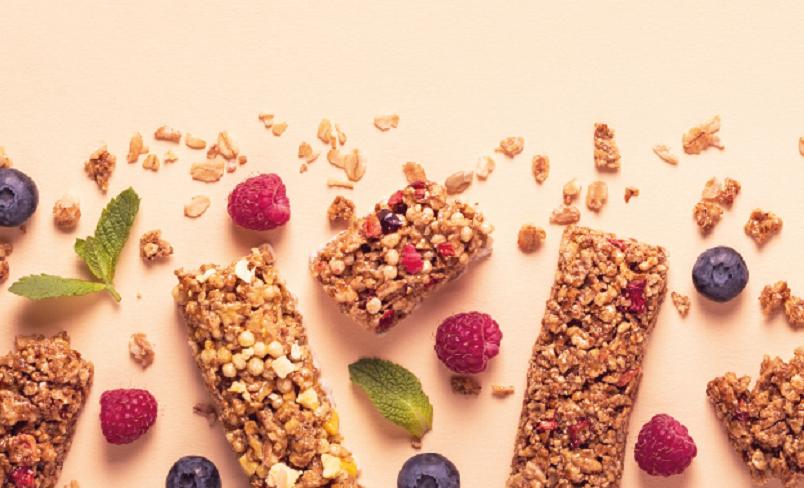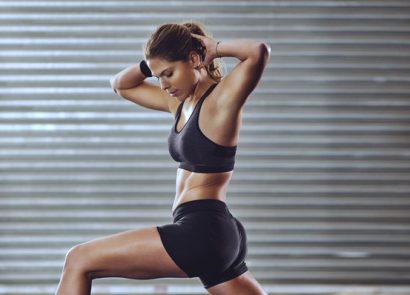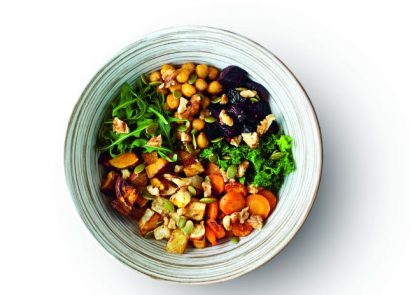It’s official, we’re a nation of nibblers – but is your daily habit worrying for your waistline? H&W investigates…
We’ve all been there: it’s 3pm, the snack box is empty and you’ve munched your way through two bags of lentil chips and more granola bars than you can shake a stick at. And, it turns out we’re not the only ones with these mid-afternoon munchies. Snacks have become such an integral part of our life, that 63 percent of employees are relying on them to get through their working day, with some even admitting to having a desk drawer dedicated to their small bites. So, we’ve enlisted the help of the experts to reveal the cause behind the snacking shift and discover their tips to help you keep your mitts out of the biscuit tin.
Generation graze
In the space of 30 years, we’ve tripled our consumption of snacks but, long gone are the days of a packet of crisps or a handful of nuts; chickpea puffs, coconut bliss balls and protein flapjacks have made it increasingly easy to nibble on the go. But, are these morphed eating habits causing problems for our waistline? “These days, we tend to eat every few hours, with three meals and two snacks being accepted as the norm, which means our bodies are existing primarily in a consistently fed state,” explains nutritional therapist, Beanie Robinson (@thehealth_ space). “These new eating behaviours have affected our key hormone regulator insulin, which means we’re now rarely tapping into our stored energy in the form of fat, as the consumption of highly refined carbohydrate snacks provides quick access to glucose. As our bodies become trapped in a cycle of eating every few hours, there could be long-term problems.” It’s not just boredom that causes us to snack mindlessly. With the rise of social media, more demands at work and money problems, us Brits are turning to food for comfort. “Many people now eat first thing when they wake up and continue grazing until they go to sleep,” says Uxshely Carcamo, founder of The Food Psychology Clinic (thefoodpsychologyclinic.co.uk). “Part of the problem also comes from our lifestyles. We’re more stressed and tired than ever and when we’re feeling like this, the willpower part of our brain doesn’t function as well and this can leave us vulnerable to making poor food choices.”
All change
While reaching for something out of the snack cupboard used to be an impulse, we can now actively plan what snacks we’re going to want and need. Just as you subscribe to Netflix for your favourite series, you can sign up to snack delivery services and have boxes sent straight to your door, with companies such as Graze, The Vegan Kind and Primal offering healthy alternatives to fulfil all your pre-empted snacking needs. And it’s not just our planning around snacks that has changed: rather than them being eaten to fill a small hole between meals, people are sourcing theirs for a nutritional boost. “Retailers have made huge adaptations to their products as consumers are wanting healthier alternatives, but aren’t willing to compromise on taste,” says Gracie Tyrell, head of brand and co-founder of Squirrel Sisters. “People want their snacks to taste delicious and contain ingredients that are good for them, so they satisfy their cravings, as well as their health.”
Learning to listen
It can be tempting to mimic others when it comes to snacking, but just because Susan from HR is hungry for an afternoon pick-meup, it’s not necessarily the time for you to reach for your pouch of nut butter (thank you, Pip & Nut). “It’s really important to listen to our hunger and fullness cues with regards to snacking,” says nutritionist, Lily Soutter (lilysoutternutrition.com). “It can be all too easy to mindlessly snack and graze at our desks, but this can wreak havoc on our waist lines and productivity.” So, do we actually need snacks if we’re eating three meals a day? “There are no hard and fast rules, as we all follow different lifestyles, but as a general rule of thumb, a balanced plate should keep us satiated for at least a couple of hours.” That’s your 2pm rice cakes out the window!
Integrating instinct
You may have heard of intuitive eating being discussed on your favourite podcast or in the news, and Beanie believes that this is the best way to determine when we actually need a snack. “Developing the ability to eat intuitively enables you to listen to the physical sensations and responding to your body in this way will help you make a snack decision based on what it needs and not what your mind is telling you what it wants,” she explains. Is there a method to follow? “If you’re at work and deciding whether to have a snack, I would encourage you to stand up from your desk and move your body. Perhaps go outside for a short walk and then have a glass of water. Having done this, you can then decide whether your body is hungry or if, in fact, you were thirsty or simply needed to move away from your desk.”
Crunch time
With the huge variety of brands that offer a selection of snacking options, you might be surprised to learn that old school crisps giant, Walkers is still the UK’s third most popular snack brand (YouGov). So, where is the snacking industry heading? To more simple and natural products, according to Uxshely. “With the amount of sugar that’s contained in foods, simple snacks, such as nuts, will become more and more popular. You can’t deny the consumer demand for healthier snacking options, so hopefully this will drive businesses to create products that are lower in sugar and higher in nutrition.” Beanie agrees. She thinks that as we become more educated about highprocessed products, whole food snacks will adapt to what we want. “Snacks that balance macronutrients can promote stable blood-sugar levels, as well as being satiating and tasty are bound to be hitting our supermarket shelves soon.” Watch this space.
Lily’s certified snack
Low-sugar peanut & chia balls
Ingredients
- 90g rolled oats
- 150g Pip & Nut or Meridian peanut butter
- 2 tbsp cacao powder
- 2 tbsp honey
- 1 tbsp chia seeds
Mix all of the ingredients in bowl until fully combined. Roll the mix into equal bite sizes and store in fridge for later.
Tip
Swap the honey for agave nectar or maple syrup to make these vegan!




















